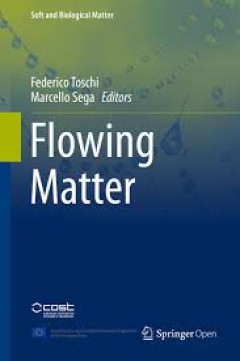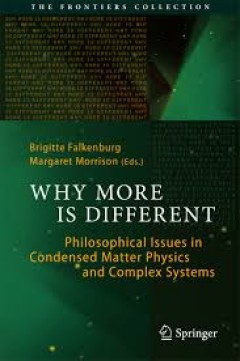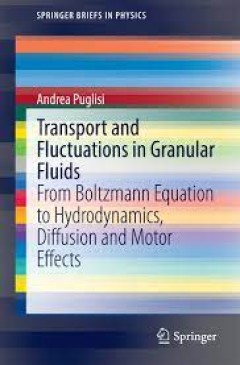Filter by

Advances in managing organic matter in turfgrass ecosystems
Many factors contribute to excessive thatch accumulation, including rapid and dense growth of the turfgrass species, excessive fertility and irrigation, and infrequent cultivation programs
- Edition
- -
- ISBN/ISSN
- 9781801463737
- Collation
- -
- Series Title
- -
- Call Number
- -

Flowing Matter
This open access book, published in the Soft and Biological Matter series, presents an introduction to selected research topics in the broad field of flowing matter, including the dynamics of fluids with a complex internal structure -from nematic fluids to soft glasses- as well as active matter and turbulent phenomena. Flowing matter is a subject at the crossroads between physics, mathematic…
- Edition
- -
- ISBN/ISSN
- 978-3-030-23370-9
- Collation
- VII, 309
- Series Title
- Soft and Biological Matter (SOBIMA)
- Call Number
- -

The Search for Ultralight Bosonic Dark Matter
To set the stage for our study of ultralight bosonic dark matter (UBDM), we review the evidence for the existence of dark matter: galactic and stellar dynamics, gravitational lensing studies, measurements of the cosmic microwave background radiation (CMB), surveys of the large-scale structure of the universe, and the observed abundance of light elements. This diverse array of observational …
- Edition
- -
- ISBN/ISSN
- 9783030958527
- Collation
- XX, 363
- Series Title
- -
- Call Number
- -

Periphery and Small Ones Matter
Dualism is closely linked with inequality. Any process of development entails forces of dispersion (centrifugal) and forces of concentration or agglomeration (centripetal). The tendency for activities to concentrate is driven by the external economies that exceeds the negative externalities (higher prices, congestion, etc.) caused by the concentration. On the other hand, external economies …
- Edition
- -
- ISBN/ISSN
- 9789811668319
- Collation
- XXIV, 143
- Series Title
- -
- Call Number
- -

Transformation Thermotics and Extended Theories
This open access book describes the theory of transformation thermotics and its extended theories for the active control of macroscopic thermal phenomena of artificial systems, which is in sharp contrast to classical thermodynamics comprising the four thermodynamic laws for the passive description of macroscopic thermal phenomena of natural systems. This monograph consists of two parts, i.e., i…
- Edition
- -
- ISBN/ISSN
- 978-981-19-5908-0
- Collation
- -
- Series Title
- -
- Call Number
- X, 344

Why More Is Different Philosophical Issues in Condensed Matter Physics and C…
The physics of condensed matter, in contrast to quantum physics or cosmology, is not traditionally associated with deep philosophical questions. However, as science - largely thanks to more powerful computers - becomes capable of analysing and modelling ever more complex many-body systems, basic questions of philosophical relevance arise. Questions about the emergence of structure, the nature o…
- Edition
- -
- ISBN/ISSN
- 978-3-662-43911-1
- Collation
- -
- Series Title
- -
- Call Number
- -

Bright galaxies, dark matter, and beyond :the life of astronomer Vera Rubin
How Vera Rubin convinced the scientific community that dark matter might exist, persevering despite early dismissals of her work. We now know that the universe is mostly dark, made up of particles and forces that are undetectable even by our most powerful telescopes. The discovery of the possible existence of dark matter and dark energy signaled a Copernican-like revolution in astronomy: not on…
- Edition
- -
- ISBN/ISSN
- 9780262366885
- Collation
- 1 online resource (256 pages)
- Series Title
- -
- Call Number
- -

Transport and Fluctuations in Granular Fluids from Boltzmann Equation to Hy…
This brief offers a concise presentation of granular fluids from the point of view of non-equilibrium statistical physics. The emphasis is on fluctuations, which can be large in granular fluids due to the small system size (the number of grains is many orders of magnitude smaller than in molecular fluids). Firstly, readers will be introduced to the most intriguing experiments on fluidized g…
- Edition
- 1st Edition
- ISBN/ISSN
- 978-3-319-10286-3-
- Collation
- -
- Series Title
- -
- Call Number
- -
Dark Energy as an Information Field and Attribute of the Universe
- Edition
- -
- ISBN/ISSN
- 978-1-83962-440-7
- Collation
- -
- Series Title
- -
- Call Number
- -

Statistical Physics of Spin Glasses and Information Processing: An Introduction
Spin glasses are magnetic materials with strong disorder. Statistical mechanics has been a powerful tool to theoretically analyse various unique properties of spin glasses. A number of new analytical techniques have been developed to establish a theory of spin glasses. Surprisingly, these techniques have offered new tools and viewpoints for the understanding of information processing problems, …
- Edition
- Ed. 1
- ISBN/ISSN
- 9780198509400
- Collation
- 256
- Series Title
- International Series of Monographs on Physics
- Call Number
- 006.32 NIS s
 Computer Science, Information & General Works
Computer Science, Information & General Works  Philosophy & Psychology
Philosophy & Psychology  Religion
Religion  Social Sciences
Social Sciences  Language
Language  Pure Science
Pure Science  Applied Sciences
Applied Sciences  Art & Recreation
Art & Recreation  Literature
Literature  History & Geography
History & Geography